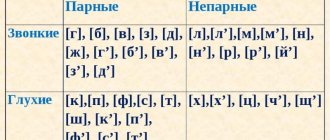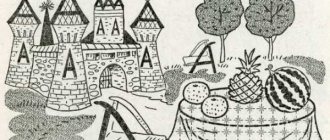Tale about the letter I
Yashka byaka The day was clear and clear, and the kitten Yasha was gloomy and angry. While walking around the yard, he gaped and fell into a hole. And now he stands there and sticks his tongue out at the pit out of frustration. But the hole doesn’t care!
- Well, okay, wait with me! - Yasha got completely angry and started teasing everyone. The frog stuck out his tongue - the frog was offended. - Yeah! It is for you!
The lizard sits, doesn’t touch anyone, so he tongues it too. The lizard's eyes clap-clap - and into tears. And Yasha is already teasing the lamb with her tongue. The lamb looked, looked and said:
- Fuck you, Yasha. - Am I a jerk?! Well then hold on!
He climbed onto a pile of boxes and shouted to the whole garden:
“Now I’ll stick out my tongue and tease you all day long.”
And then a ripe apple fell from the apple tree and hit Yasha’s forehead - bam!
- Meow!!! - the frightened Yasha screamed, thinking that a hawk had attacked him from above.
He fell head over heels from the boxes, tail and home!
- I’ll tell mom everything!
And everyone laughs:
- Byaka-boyaka and sneak!
(G. Yudin)
Lesson summary “Teaching literacy. Introducing the letter "s". 1st grade. UKM "School of the 21st century".
Literacy lesson 1st grade. UKM "School of the 21st century"
Topic: introduction to the letter “Y”.
Purpose: to introduce the letter Y, the sound y
Objectives: *educational: introduce the sound s and a graphic example of the letter, develop sound analysis skills; * developing: develop speech breathing and voice strength, phonemic hearing, spatial perception, develop smooth reading skills, expand students' vocabulary, develop concentration and voluntary switching; *educational: to cultivate respect for the opinions of comrades, respect for each other, the ability to listen and hear another person.
During the classes.
1.Organizational moment.
2. Updating knowledge. — Guys, listen to the poem and try to determine the topic of today’s lesson.
Our story without the letter Y is like a lawn without grass. Or, say, a treat without quince and without halva. But great minds, including, of course, us, have never heard of a word starting with the letter Y.
They, and we, and you, remembered unsuccessfully And wept inconsolably s-s-s-s-s! - Guys, who guessed what the topic of today's lesson is? (introduction to the letter “Y”) Slide 1. - Well done! Let's formulate the goals of the lesson. (Learn to hear Y in words, learn to make a sound diagram of words, learn to pronounce the sound Y correctly.)
- You will find out who came to our lesson and brought the duty letter on his tail by guessing the riddle. She lives in water. There is no beak, but she pecks. (fish)—picture. 3.Work to consolidate what has been learned. — To create a sound pattern for the word “fish,” let’s remember the algorithm for working on the sound pattern. ALGORITHM 1. I pronounce the word. 2.I determine the number of sounds. 3.I analyze the sounds in order. 4.I determine the location of the new sound. 5. I designate a new sound.
4.Independent work. Working on a diagram of the word “fish” according to an algorithm - they work independently in the field, one student works at the board. We check the board. - Now let’s determine the position of the letter Y on the “ribbon of letters.”
5.Formation of new knowledge.
Slide 2. - Look at the screen and answer, what does the letter Y look like? (guys answers)
Slide 3. Reading a poem in chorus, the student at the screen follows with a pointer. Here's an axe. The log is nearby. It turned out exactly what we needed. The result is the letter s - We all should know it.
- So what does the letter Y look like? — What else is the letter Y compared to? We’ll find out from the poem on the board. ON THE DESK. They read in chorus, the student at the blackboard follows with a pointer.
S...What a fatty you are! Your tummy is like a pillow. To make it easier for her to walk, she had to get a stick. (Children answer the question)
- Now let's play. Game ". Hear the sound." If a word has a new sound, the guys clap their hands. If there is no sound, they are silent. Fish, jump rope, cube, letters, desk, roof, dad, postcard, birds. ON THE DESK. Read a poem in chorus. -What other words could be added to our game, we learn from the poem?
This bkuva happens at the end and in the middle. At the end there is cabbage, rutabaga, and in the middle there is melon. The guys answer the question posed before reading. —And now we will hold a competition in groups “Who can come up with the most words with “Y”. - What part of the word cannot contain the letter Y, do you think? (guys' assumptions) - Now we will find out which of the guys is right. Let's read the poem.
ON THE DESK. They read a poem in chorus, the student at the blackboard follows with a pointer.
We asked the painters: - Tell me, painters, Where can I find a dozen words that contain the sound “y”? The painters answered us: “There is no such case that the sound “y” would ever appear at the beginning of a word!”
(The guys answer the question posed before reading.)
6.Independent work. Work in pairs. Work according to the textbook on p. 55. "Solve the crossword." The teacher keeps in touch with the children using the form of an open palm “It’s clear - it’s not clear.” Summing up the results of the work. SELF-ASSESSMENT - Raise your hand, those guys who guessed all the words. Well done! Etc. - Name all the words that you came up with. (Cheese, goats, pumpkin, beads.)
7. Reflection. ON THE DESK. They read in chorus. In the Russian language, alas, there are no words starting with “y”. - So, what conclusion can be drawn from these lines? Does the Russian language have a capital letter “y”? - Why?
8. Summing up the lesson.
- Let’s summarize the lesson using the words: I understood... I learned...
I learned... I remembered...
9.Self-assessment for the lesson.
kopilkaurokov.ru
Assignment: printed letter I for preschoolers
Look at the letter Y. Write it in the air, and now in your notebook, carefully in the cells with a simple pencil or ballpoint pen.
In cases where the child is asked to write a whole line of a letter, syllable or word, the adult gives a writing sample at the beginning of the line. If a preschooler has difficulties, then an adult can draw two approximate lines, or put reference points that the child will connect with lines, or write the entire letters, and the child will simply circle them in a different color. Calligraphy should not be required at this stage of training.
Print
Summary of a literacy lesson, introduction to the letter Yaya Program School of the 21st century
The summary was compiled by the primary school teacher of the Municipal Budgetary Educational Institution "Karagalinskaya Secondary School" Mukhamedova Gulchira Absattarovna Academic subject: Teaching literacy Class 1 "Primary School XXI" The topic of the lesson is "Acquaintance with the letter I I" (first lesson) The purpose of the lesson: to introduce the letter I, I and its work, to designate sound and indicate the softness of the consonant in front.
To practice the ability to conduct a sound analysis of a word with determining the quality of sounds in a word (vowel, hard and soft consonant). Develop phonemic awareness and speech of students. To foster in children an interest in cognitive activity and learning. Equipment: presentation, pictures, chips, letters for everyone. Lesson progress Organic moment. Now let's start the lesson with a sound warm-up. Say each word, if there is a sound [a], then clap your hands. (slides (1-4) 3. Actualization of knowledge - Let's remember what sounds there are? (vowels and consonants) - What consonant sounds are there? (hard and soft) ) -What chip do we denote a soft consonant sound? -What chip do we denote a hard consonant sound? -What chip do we denote vowel sounds? -And now Vdovin Vova will read to us an excerpt from Victor Lunin’s poem “I once saw it myself.” I once saw it myself Yak flew in heaven, I'm not lying, believe me, I saw it in a dream. (5 slide) Vocabulary work: - Guys, are you familiar with the word Yak Yak is an animal with a long body and short legs. The yak is from the family of real bulls. Look, what does this animal look like. (show a photograph, picture, drawing at the discretion of the teacher) - Vika, please tell me what letter does each line in the poem passage begin with? (me) 4. Who guessed what letter we will meet today? - Correct , today we will get acquainted with the letter I. -Look what it looks like. (6th slide) -What elements does the letter I consist of? (straight, semi-oval, oblique) -Which direction does the letter I face? -Let's show the letter I together. They sat down quietly _ And now they opened the primer on page 32 (three, two) - Guys, what can’t you play football without? -And now we will perform a sound analysis of the word ball together. -Put the chips in front of you. The diagram of the word ball consists of how many windows? (three) - So how many sounds are there in the word ball? (3) — Let’s pronounce the word ball so that we can clearly hear the first sound. -What is the first sound in a word? (Consonant) -How do we pronounce it? (softly) -What kind of chip do we designate? (green) -Now let’s pronounce the word so that we can clearly hear the second sound? -What is the second sound? (a) -Is it a vowel or a consonant? (vowel) -Why? (the air comes out freely without obstacles) _What kind of chip do we denote? (red) -Remember the rule of the Russian language. The sound [a] after a soft consonant is never denoted by the letter a; after a soft consonant it is denoted by the letter i. _ You each have the letter I on your table, put it under the red chip. -pronounce the word so that the third sound is clearly heard -What is the third sound? (h) -How do we pronounce it? (with an obstacle) -What sound is that? (consonant) -Now determine hard or soft? (soft) -what kind of chip do we denote? (green) The sound [h] does not have a hard pair, it is always soft - Now let’s warm up with the funny little people? Everyone stand up. I will ask riddles, and you will show the answer with the movement of a cheerful little man (according to the Bazarny program there are cheerful little men, I hang them on the wall under the answers) 1. White House With a yellow tenant. The house is cracking, the tenant is squeaking. What kind of house is this? We show. (egg) 2. I won’t tear off the rosy nesting doll for anything, I’ll wait until the nesting doll falls into the grass on its own. (apple) Always in the mouth, not swallowed. (language) - guys, what unites all three words? (they start with b weburok.com



